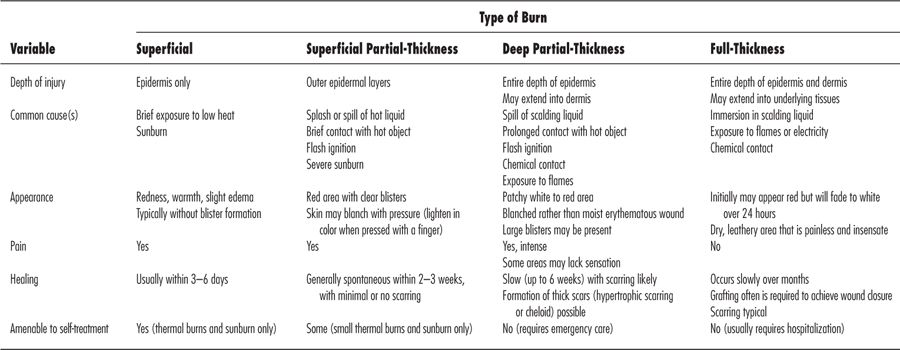Overview
Burns are tissue injuries caused by thermal, electrical, or chemical contact, or by exposure to ultraviolet radiation (i.e., sunburn).
Thermal burns result from skin contact with flames, scalding liquids, or hot objects (e.g., irons, oven broiler elements, hot pans, curling irons, or radiators). Minor thermal burns are amenable to self-treatment.
Sunburn is a type of thermal burn caused by acute overexposure to natural sunlight (primarily ultraviolet band B), tanning beds, or ultraviolet lamps. Many cases of sunburn are amenable to self-treatment.
Inhalation burns are a type of thermal burn caused by inhalation of smoke or hot vapors. Inhalation burns are not amenable to self-treatment. Patients who have inhaled smoke or heated gas should be transported quickly to a hospital emergency room by emergency services personnel.
There are two types of electrical burns: (1) flash electrical burns, which result from a high-temperature arc of current close to the skin, and (2) contact electrical burns, which are caused by contact with a high-voltage source. Electrical burns always injure the skin because the electrical energy is dissipated as heat; they are not amenable to self-treatment. Patients should be evaluated by an emergency medical care provider.
Chemical burns can result from skin contact with acids or alkalis contained in household products, as well as from substances used in the workplace. Patients with chemical burns should seek emergency medical care after initial first-aid measures are administered.
 Epidemiology
Epidemiology
- More than 500,000 patients per year are estimated to receive burn injuries that require medical treatment.
- Most burns (with the exception of sunburn) occur in the home and usually are thermal burns.
 Signs and Symptoms
Signs and Symptoms
- The traditional classification of burns as first, second, or third degree has been replaced by the terms superficial, superficial partial thickness, deep partial thickness, and full thickness, which are related to the depth of injury to the skin. Descriptions of each type of burn are provided in Table 1.
- Sunburn usually causes a superficial burn injury, characterized by erythema and slight dermal edema resulting from an increase in blood flow to the affected skin.
- With mild exposure, erythema with subsequent scaling and exfoliation (“peeling”) of the skin occurs. Pain and low-grade fever may accompany the erythema.
- More prolonged exposure causes pain, edema, skin tenderness, and possibly blistering.
- With mild exposure, erythema with subsequent scaling and exfoliation (“peeling”) of the skin occurs. Pain and low-grade fever may accompany the erythema.
- Severe sunburn can lead to blistering (partial-thickness injury), fever, chills, vomiting, delirium, and shock. If blisters occur, they will desquamate or peel over a period of several days.
 Complications
Complications
- Burns in which the epithelium is lost and the surface is weeping (superficial partial-thickness or deeper burns) are prone to surface infection. Infection can worsen the severity of a burn injury, its depth, or both.
 Treatment
Treatment
- Only superficial thermal burns (including sunburn) and some small superficial partial-thickness thermal burns are amenable to self-treatment.
- Thermal burn injuries that are deeper or affect >1%–2% of a patient’s body surface area require medical attention or hospital care. An easy way to estimate the extent of a burn is to use the back of the hand as 1% of body surface area.
- Patients with deep partial-thickness burns and full-thickness burns should be examined in a hospital’s emergency department.
- Patients should seek emergency medical attention for all burns that affect the eyes, ears, face, or perineum (genitalia).
- Patients with chemical, electrical, or inhalation burns of any depth should be examined in a hospital’s emergency department. First-aid measures for chemical burns may be initiated while waiting for emergency personnel to arrive (see the following section First-Aid Measures for Chemical Burns).
- Patients with deep partial-thickness burns and full-thickness burns should be examined in a hospital’s emergency department.
- Pain usually is the chief complaint of patients seeking treatment for superficial and superficial partial-thickness burns. The goals of treatment are to relieve pain associated with the burn, as well as to provide physical protection and a favorable healing environment that minimizes the chances of infection and scarring.
TABLE 1. Classification and Characteristics of Burns

 First-Aid Measures for Chemical Burns
First-Aid Measures for Chemical Burns
Stay updated, free articles. Join our Telegram channel

Full access? Get Clinical Tree


